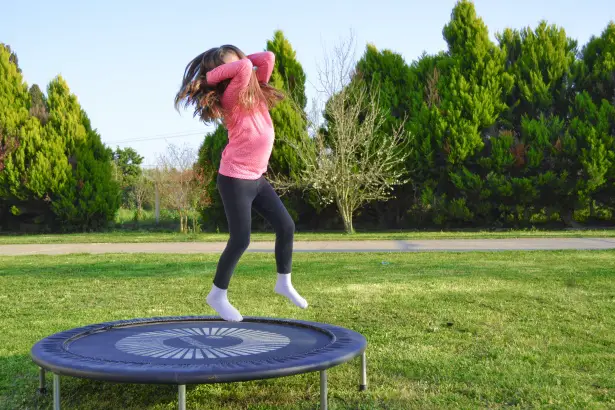Do you know How long to jump on a trampoline to lose weight? In recent years, trampoline exercise has become an increasingly popular form of workout. Not only is it fun and enjoyable, but it also has numerous health benefits, including weight loss.
Trampoline exercise involves jumping on a trampoline, which can help to burn calories, build endurance, and strengthen muscles.
For those looking to lose weight, trampoline exercise can be an effective way to achieve their goals. However, the question arises: how long should one jump on a trampoline to lose weight? The answer to this question is not straightforward, as it depends on several factors such as the intensity, frequency, and duration of the exercise.
This article will explore the benefits of trampoline exercise for weight loss and provide guidelines for the recommended duration of trampoline exercise for beginners, intermediate, and advanced levels.
Additionally, we will discuss tips for effective trampoline exercise and precautions to take to ensure safety during trampoline workouts. So, if you are looking for an enjoyable and effective way to lose weight, read on to discover how trampoline exercise can help you achieve your goals.
How long to jump on a trampoline to lose weight: The duration for trampoline jumping to aid weight loss varies but generally 20-30 minutes of continuous moderate to intense bouncing, combined with a balanced diet, can be effective for shedding pounds.
How Long to Jump on a Trampoline to Lose Weight?

The length of time needed to jump on a trampoline to lose weight can vary depending on factors such as your weight, intensity level, and frequency of jumping.
According to Harvard Health Publishing, a person who weighs 125 pounds can expect to burn approximately 90 calories during 30 minutes of light hopping on a trampoline.
However, a more vigorous workout of jogging in place on a trampoline can burn up to 170 calories in 30 minutes. Other activities like jumping jacks, burpees, and other types of jumps can also be done on the trampoline and can lead to additional calorie burning.
To achieve weight loss goals, it’s recommended to engage in trampoline jumping for at least 30 minutes to an hour, several times a week, in addition to a healthy diet.
However, it’s important to speak with your doctor before starting a new exercise regime, as trampoline jumping can be considered a high-impact activity, so it may not be suitable for everyone.
How Trampoline Jumping Can Help You Lose Weight
If you want to lose weight, you need to burn more calories than you eat. You can do this by exercising and eating less. If you decide to do trampoline exercise, you need to do it regularly.
The government recommends doing at least 150 minutes of exercise every week, like jumping on a trampoline. If you want to lose weight, you might need to do more exercise, up to 300 minutes every week. You can spread your exercise throughout the week and do it in at least 10-minute sessions.
Is 10 Minutes of Jumping on a Trampoline Enough?
No, 10 minutes of jumping on a trampoline is not the same for everyone. It depends on what you want to achieve, your body type, and how hard you jump. For some people, 10 minutes of jumping is enough to improve their fitness and agility.
But, if you want to build muscle and get stronger, you might need to jump for longer and with more effort. So, the amount of jumping you need to do depends on what you want to achieve and what your body needs.
Calories Burned in 30 Minutes of Trampoline Exercise
How many calories you burn on a trampoline depends on how hard you work and what you do. If you jump lightly on a trampoline for 30 minutes, you might burn about 90 calories if you weigh 125 pounds.
But, if you do more active things like jogging or jumping jacks, you could burn up to 170 calories in 30 minutes.
It’s important to talk to your doctor before starting any new exercise, especially if you’re not sure if it’s safe for you. Jumping on a trampoline can be tough on your body, so it might not be good for everyone.
Which is Better: Walking or Jumping on a Trampoline?
It depends on what you want to achieve. Walking can be really good for your health, as it can give you a workout that can make your legs stronger and help you lose weight. It can also improve your balance and coordination.
Jumping on a trampoline can also be good for your health, and it’s a lot of fun! It’s a gentle form of exercise and can help you get a good cardio workout.
It’s up to you to decide which one you like better. If you want to have fun while getting fit, jumping on a trampoline might be the right choice. But if you want to focus on health benefits, walking might be better for you.
A Great Exercise for Women’s Health
If you’re a woman, you may have heard of your pelvic floor, a group of muscles that supports your uterus, bladder, and colon. If these muscles are weak, it can cause problems.
According to Johns Hopkins Medicine, half of women between the ages of 50-79 years old have some degree of uterine prolapse or vault collapse. Strengthening the pelvic floor is important for women of all ages.
Trampolines can help with that, too! Regular bouncing on a soft trampoline can improve blood flow and responsiveness in the pelvic floor.
This can also help women who suffer from incontinence, where a little urine leaks when they jump or sneeze, to strengthen their pelvic floor muscles and prevent bladder accidents.
The Benefits of Jumping on a Trampoline Every Day
Jumping on a trampoline every day is good for your body and mind. It helps your muscles get stronger and can be a fun activity to do with friends and family. Jumping on a trampoline works many muscles like the legs, arms, and stomach, and can improve your balance.
It also helps you relax and be creative. Studies show that just 20 minutes of trampoline jumping each day can make you feel happier and more focused. It is also good for your heart and can be a fun way to spend time. Jumping on a trampoline every day is a great way to stay healthy and happy!
How long do you have to jump on a trampoline to lose 1 pound?
To lose one pound of weight, you need to burn approximately 3,500 calories. The number of calories burned during trampoline exercise depends on various factors such as your body weight, intensity of exercise, duration of exercise, and frequency of exercise.
According to the American Council on Exercise, a 125-pound person can burn about 210 calories during a 30-minute session of trampoline exercise, while a 155-pound person can burn about 260 calories during the same session. A 185-pound person can burn around 311 calories in 30 minutes of trampoline exercise.
Therefore, to lose one pound of weight, a 125-pound person would need to do around 17 trampoline exercise sessions of 30 minutes each, while a 155-pound person would need to do around 13 sessions and a 185-pound person would need to do around 11 sessions.
However, it is important to remember that weight loss is not just about exercise. A healthy and balanced diet, along with regular physical activity, is essential for weight loss and maintaining a healthy weight.
Jumping on a trampoline can be a fun and effective way to supplement your weight loss efforts, but it should be combined with other healthy lifestyle habits for optimal results.
How long should you should you wait to jump on a trampoline after eating
It is generally recommended that you wait at least 30 minutes to an hour after eating before jumping on a trampoline. This is because jumping up and down on a trampoline can cause your stomach to move around, which may result in discomfort or nausea if you have recently eaten.
Jumping on a trampoline on a full stomach can also increase the risk of acid reflux or heartburn, as the bouncing motion can cause stomach acid to rise up into the esophagus.
To avoid any potential discomfort or health issues, it’s best to wait until your food has had time to digest before jumping on a trampoline. If you’re unsure about how long you should wait based on your specific situation, it’s always a good idea to consult with your doctor.
How long should you jump on a mini trampoline?

The length of time you should jump on a mini trampoline, also known as a rebounder, depends on your fitness level and goals.
It is generally recommended to start with shorter sessions and gradually work your way up.
For beginners, starting with 5-10 minutes of rebounding per day is a good starting point. As your fitness level improves, you can increase the duration of your rebounding sessions to 20-30 minutes.
It’s important to listen to your body and not overdo it, as jumping on a trampoline can be a high-impact exercise. If you experience any discomfort or pain while rebounding, stop immediately and rest.
In addition, make sure to warm up before jumping on the trampoline and cool down afterward to prevent injury. It’s also recommended to wear comfortable athletic shoes and clothing and to use a trampoline with a sturdy frame and supportive mat.
How long should you jump on a trampoline for lymphatic drainage
The recommended time for jumping on a trampoline for lymphatic drainage is about 10 to 20 minutes per day. However, it’s important to note that the frequency and intensity of trampoline exercise should be tailored to the individual’s fitness level and overall health.
For those who are new to trampoline exercise, it’s recommended to start with shorter sessions of 5 to 10 minutes per day and gradually increase the duration over time. It’s also important to listen to your body and take breaks if you feel fatigued or experience any discomfort.
When it comes to lymphatic drainage specifically, it’s important to focus on gentle bouncing movements rather than high-impact jumps or intense workouts. This means keeping both feet on the trampoline at all times and using small, controlled movements to stimulate the lymphatic system.
It’s also important to stay hydrated before and after trampoline exercise to support the lymphatic system and flush out toxins. Additionally, wearing comfortable clothing and supportive footwear can help prevent injury and improve overall comfort during trampoline exercise.
How long should you jump on a trampoline to lose weight
The length of time you should jump on a trampoline to lose weight depends on various factors, including your weight, intensity of exercise, and diet. Generally, to lose weight, you need to create a calorie deficit by burning more calories than you consume.
Jumping on a trampoline is a form of cardio exercise that can help you burn calories and achieve your weight loss goals. According to research, trampoline jumping can burn between 160-240 calories in 30 minutes, depending on the intensity of your workout.
To lose one pound of body weight, you need to create a calorie deficit of approximately 3,500 calories. Therefore, if you want to lose one pound per week, you need to create a calorie deficit of 500 calories per day.
You can achieve this by combining a healthy diet with regular exercise, including trampoline jumping.
Assuming that you burn 200 calories by jumping on a trampoline for 30 minutes, you would need to jump for 17.5 hours to burn 3,500 calories, equivalent to one pound of body weight.
This means that to lose one pound per week by jumping on a trampoline alone, you would need to jump for approximately 2.5 hours per day, every day.
However, it’s important to note that jumping on a trampoline alone is unlikely to lead to significant weight loss without a healthy diet and other forms of exercise.
Therefore, it’s recommended to combine trampoline jumping with other forms of exercise, such as strength training and cardio, and to follow a balanced and healthy diet for optimal weight loss results.
How long should you jump on a trampoline for exercise
The amount of time you should jump on a trampoline for exercise depends on your fitness level and goals. For beginners, it is recommended to start with 5-10 minutes per session and gradually increase the time as your fitness improves.
For general health benefits, the American College of Sports Medicine recommends at least 150 minutes of moderate-intensity exercise per week, which can be achieved through 30 minutes of exercise on most days of the week. This can be done in several sessions throughout the day.
For weight loss, the amount of time you should jump on a trampoline for exercise may vary depending on your intensity and frequency of exercise.
As a general guideline, you may need to jump on a trampoline for 30-60 minutes per day, at least 5 days a week to see significant weight loss results.
It is important to listen to your body and avoid over-exercising, which can lead to injury. If you have any health concerns or medical conditions, it is recommended to consult with your healthcare provider before starting a new exercise routine.
How long should you jump on a trampoline for a workout?

The duration of a trampoline workout depends on your fitness level, goals, and the intensity of your workout.
It is generally recommended to start with shorter sessions and gradually increase the duration as your fitness level improves.
For beginners, a 15 to 20-minute trampoline workout can be a good starting point, gradually increasing to 30 to 45 minutes per session. More experienced trampoline users may perform workouts that last for an hour or more.
It’s important to listen to your body and avoid overexertion. Taking breaks between sessions and staying hydrated during your workout is also crucial. Remember to warm up before starting your trampoline workout, and cool down afterward to prevent injury.
Combining Trampoline Workouts with a Balanced Diet
Below, we discuss combining trampoline workouts with a balanced diet:
1. The Importance of Nutrition
To start, we explore the importance of nutrition:
Role of Diet in Achieving Fitness Goals:
- Emphasize the critical link between diet and fitness goals.
- Highlight how a well-rounded diet supports weight loss and muscle gain.
- Explain the impact of calorie intake on body composition.
Nutrient-Rich Foods for Energy and Recovery:
- Discuss the significance of carbohydrates for energy during trampoline workouts.
- Promote the consumption of lean proteins for muscle repair and growth.
- Stress the importance of incorporating healthy fats, vitamins, and minerals.
Importance of Portion Control:
- Educate on portion sizes and how they affect calorie intake.
- Provide tips on mindful eating and recognizing satiety cues.
- Encourage balanced meals and snacks for sustainable energy.
2. Hydration and Recovery
Next, we will explore the hydration and recovery:
Staying Hydrated During Trampoline Workouts:
- Explain the role of water in regulating body temperature and preventing dehydration.
- Offer guidance on how much water to consume before, during, and after workouts.
- Suggest alternatives like electrolyte-rich drinks for intense sessions.
Post-Workout Nutrition for Muscle Recovery:
- Emphasize the importance of consuming nutrients promptly after a workout.
- Recommend a mix of carbohydrates and protein to aid recovery.
- Provide examples of post-workout snacks or meals.
Does jumping on a trampoline help you lose belly fat
Jumping on a trampoline can help you lose overall body fat, including belly fat, as part of a well-rounded exercise and diet plan. When you jump on a trampoline, your body burns calories and fat for energy, which can contribute to weight loss.
However, it’s important to note that spot reduction, or losing fat in a specific area such as the belly, is not possible. Weight loss and fat reduction occur throughout the body, not just in one area.
To effectively lose belly fat, you should engage in regular exercise that includes cardio and strength training, as well as follow a healthy diet that is low in processed foods, sugar, and saturated fat. This combination of exercise and healthy eating can lead to overall fat loss, including in the belly area.
Factors that affect weight loss on a trampoline

When it comes to losing weight, many people turn to exercise as a way to shed unwanted pounds.
Trampoline jumping is a fun and effective way to get in shape and lose weight, but how long and how often should you jump to see results?
There are several factors that can affect weight loss on a trampoline, including the intensity, duration, and frequency of exercise.
Intensity of Trampoline Exercise:
The intensity of your trampoline workout is a key factor in how many calories you can burn and how quickly you can lose weight. Jumping at a moderate to high intensity can burn anywhere from 150 to 300 calories in just 30 minutes, depending on your weight and exertion level.
To increase the intensity of your trampoline workout, try adding in some high-intensity interval training (HIIT). This involves short bursts of intense jumping followed by periods of rest or lower-intensity bouncing.
HIIT has been shown to be an effective way to burn calories and increase fitness levels and can help you lose weight faster than steady-state cardio.
Duration of Trampoline Exercise:
The duration of your trampoline workout is another important factor to consider when trying to lose weight. Ideally, you should aim to jump on the trampoline for at least 20-30 minutes per session, at least three to four times a week.
However, it’s important to work up to this gradually if you’re new to trampoline jumping. Start with shorter sessions of 10-15 minutes and gradually increase the length and intensity of your workout as your fitness level improves.
It’s also important to listen to your body and take breaks as needed. Overdoing it on the trampoline can lead to muscle soreness, fatigue, and even injury, so be sure to pace yourself and give your body time to rest and recover between sessions.
Frequency of Trampoline Exercise:
The frequency of your trampoline workouts is also important for weight loss. While jumping on the trampoline once a week can provide some health benefits, it may not be enough to see significant weight loss results.
Aim to jump on the trampoline at least three to four times a week for optimal weight loss results. This will help you maintain a consistent exercise routine and ensure that you’re burning enough calories to lose weight.
It’s also important to mix up your trampoline workouts to prevent boredom and keep your body challenged. Try incorporating different types of jumps, such as high knees, jumping jacks, and tuck jumps, as well as strength-building exercises like squats, lunges, and push-ups.
Precautions and safety measures
Trampoline exercises can be a fun and effective way to stay active and improve your health. However, it is important to take certain precautions and safety measures to prevent injuries.
Before starting a trampoline exercise program, it is highly recommended that you consult with a doctor, especially if you have any medical conditions or injuries that could be aggravated by the physical activity.
A medical professional can assess your fitness level and provide guidance on how to safely incorporate trampoline exercises into your routine.
Additionally, it is important to follow safety measures to prevent injury. Here are some guidelines to keep in mind:
Purchase a quality trampoline: Invest in a high-quality trampoline from a reputable manufacturer that meets safety standards. Check for any defects or damage before use, and make sure the trampoline is placed on a flat and level surface.
Use safety equipment: Always wear proper athletic shoes and consider wearing ankle braces for added support. Use a safety enclosure or netting to prevent falls and provide a barrier between you and the springs or frame.
Supervision: Trampoline exercises should be done under the supervision of an experienced trainer or with a partner. This is especially important for children, who should never use a trampoline unsupervised.
Start slow: Begin with low-impact exercises and gradually increase the intensity and duration over time. Avoid performing complex moves or stunts until you have mastered basic trampoline exercises.
Warm-up and cool down: As with any exercise program, it is important to warm up your body before jumping on the trampoline and to cool down afterward. This can help prevent muscle strains and other injuries.
Pay attention to your body: If you experience pain or discomfort while exercising on the trampoline, stop immediately and rest. Pushing through pain can lead to more serious injuries.
Avoid overuse: Jumping on a trampoline can be a high-impact exercise, so it is important to avoid overuse. Limit your trampoline exercises to a few times per week, and alternate with other forms of exercise to avoid putting too much strain on your joints.
By following these precautions and safety measures, you can enjoy the many benefits of trampoline exercises while minimizing the risk of injury.
Remember to consult with a doctor and an experienced trainer before starting any new exercise program, and always listen to your body to prevent overuse or injury.
FAQs:
Q.1 Is jumping on a big trampoline good exercise?
Yes, jumping on a big trampoline is an excellent form of exercise that can provide numerous benefits such as improving cardiovascular health, enhancing balance and coordination, boosting lymphatic circulation, and increasing bone density.
Q.2 Is jumping on a trampoline good exercise for weight loss?
Yes, jumping on a trampoline can be an effective exercise for weight loss. It can burn calories and fat, especially when combined with a healthy diet and consistent exercise routine.
The amount of weight loss you can achieve will depend on various factors such as your body weight, the intensity and duration of your trampoline workout, and your overall lifestyle habits.
Q.3 How long should you jump on a trampoline for a workout?
The duration of your trampoline workout will depend on your fitness level and goals. Generally, 15-20 minutes of jumping on a trampoline can provide an effective cardiovascular workout.
However, for weight loss and building endurance, you may need to jump for 30-60 minutes, several times a week.
Q.4 What happens if you jump on a trampoline every day?
Jumping on a trampoline every day can provide numerous health benefits such as improving cardiovascular health, enhancing lymphatic circulation, and increasing bone density.
However, it’s important to vary your trampoline workout and not overdo it, as repetitive stress on your joints can lead to injuries. It’s best to start slowly and increase the intensity and duration of your trampoline workout gradually.
Q.5 Is jumping on a trampoline good for your lymphatic system?
Yes, jumping on a trampoline is an excellent way to stimulate lymphatic circulation and promote detoxification. The up-and-down movement of jumping helps to stimulate the lymphatic system, which helps to remove toxins, waste products, and other unwanted substances from the body. This can enhance your immune function and improve overall health.
Conclusion:
In conclusion, the duration of trampoline jumping to lose weight can vary based on individual factors. Consistency and intensity are key.
Jumping on a trampoline for 10 minutes may provide some benefits, but longer sessions of 20 to 30 minutes, multiple times per week, are more effective. This exercise can contribute to weight loss by burning calories.
On average, a 30-minute trampoline session can burn a significant amount of calories. Furthermore, trampoline jumping is not only beneficial for weight loss but also for women’s health, as it provides a great overall workout.
To achieve specific weight loss goals, it’s important to consider that one pound of weight loss requires a calorie deficit of approximately 3,500 calories.
Thus, the duration of trampoline jumping needed to lose one pound depends on factors such as intensity, frequency, and individual metabolism.
Regarding safety, it’s recommended to wait at least an hour after eating before jumping on a trampoline to avoid any discomfort.
Additionally, it’s important to follow precautions and safety measures while using a trampoline, such as using it on a flat surface, ensuring proper supervision, and avoiding risky maneuvers.
Overall, trampoline jumping can be an effective exercise for weight loss, but the duration needed depends on various factors. It’s crucial to maintain a balanced diet, consider individual goals, and prioritize safety when incorporating trampoline jumping into a fitness routine.
We hope this guide has helped you understand how long you need to jump on a trampoline to lose weight. If you have any questions, please leave them in the comments section below.

